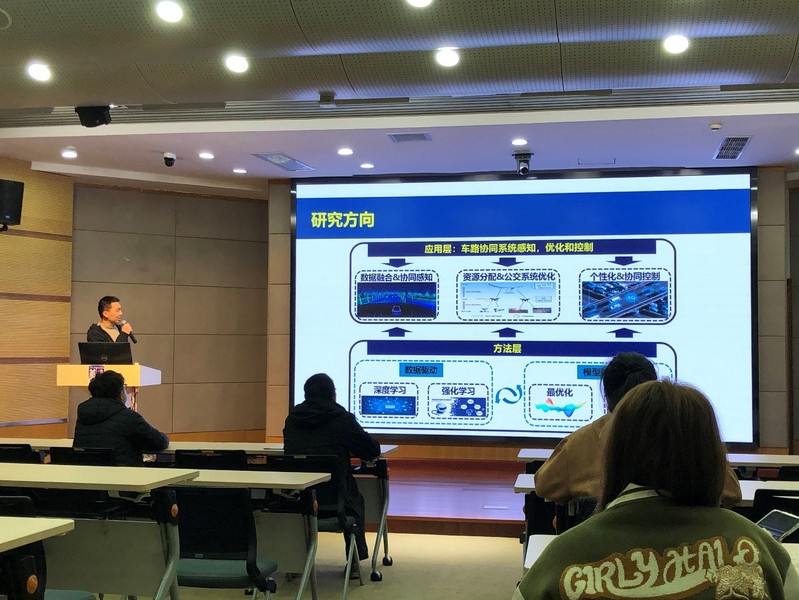On March 28th, the Hujiang Economics and Management Forum Series (93rd Session) was successfully held at Lecture Hall of the Second Conference Room. Dr. Yunyi Liang from the Department of Transportation Systems Engineering was invited to give an academic lecture on the topic of Sensing and Control Methods of Networked Autonomous Vehicles. Dr. Jiao Yao from the Department of Transportation Systems Engineering attended the lecture, which was hosted by Dr. Anquan Liu from the Department of Systems Engineering.
At the beginning of the lecture, Dr. Liang briefly explained the mainstream methods of lane-changing decision and trajectory planning, and focused on the research content of the joint optimization of lane-changing decision and trajectory for CAV based on hierarchical reinforcement learning. The idea frameworks of the DDQN reinforcement learning model in the decision layer and the CARLA simulation model in the trajectory layer are explained respectively, and the two-layer model is trained alternately using the time-asynchronous difference algorithm to achieve good control results.
Subsequently, Dr. Liang reviewed the current research status of CAV merging control methods and federated element reinforcement learning algorithms, and shared the CAV merging control method based on federated element multi-intelligent body reinforcement learning. The reward function, action space and state space of the intelligent body are described. The federated learning algorithm is designed to realize the sharing of training data among the intelligences while protecting data privacy to overcome the problem of high sample demand for the training of this model. A meta-learning algorithm is constructed to train the model of each CAV to solve the problem of poor accuracy of federated learning due to the heterogeneity of data distribution. Further, Dr. Liang compares the proposed method with the CAV merging control method based on multi-intelligence reinforcement learning and the CAV merging control method based on federated multi-intelligence reinforcement learning to verify the advantages of the proposed method.
After that, Dr. Liang explained the main principle of the laser point cloud denoising method based on federated meta unsupervised learning. Specifically, he introduced the use of multi-stage wavelet convolutional neural network to realize laser point cloud denoising, the use of federated learning algorithm to realize data sharing under CAV privacy protection, and the establishment of a meta-learning algorithm to update the weights of CAV multi-stage wavelet convolutional neural network in order to solve the problem of low accuracy of federated learning due to the heterogeneity of data distribution.
Finally, Dr. Liang explained the existing detection bases, detection methods, detection defects and mainstream diagnosis methods for lane line detection and pavement traffic sign damage diagnosis, and focused on the lane line extraction based on FE-Mask R-CNN and the diagnosis of pavement traffic signs based on LPIPS, respectively.
During the lecture, Dr. Liang discussed in depth with Dr. Yao and Dr. Liu about the analyticity of reinforcement learning and the convergence of training curves. The lecture was successfully concluded in an open and active atmosphere.



